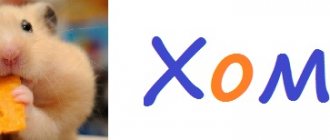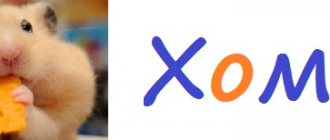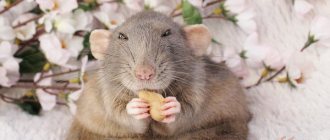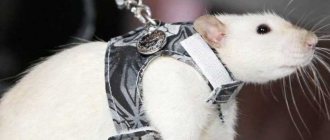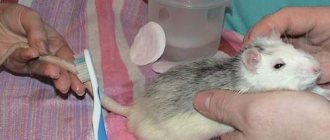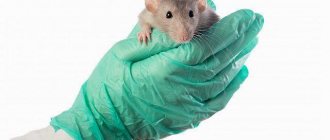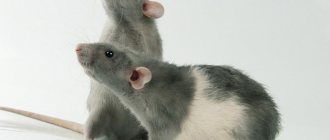- home
- Rat
- Care
07/10/2019 Rat teeth are amazingly sharp and hard. The jaws of a small rodent easily create a pressure of over 1.5 tons per 1 cm². Such jaw power allows the animal to easily bite through lead pipes and steel wire, chew cinder blocks, etc. This article will discuss the characteristics of the teeth of the animal, which is gaining popularity as a pet, as well as the prevention of dental diseases in rodents.
Anatomical features
In most mammals, the chewing surface is arranged in a certain way. Their dentition consists of the following types of teeth:
- incisors;
- molars (or molars);
- premolars;
- fangs.
Unlike most mammals, rats have a more specific jaw structure. The dentition of these rodents includes only two types of teeth out of four possible, these are:
- incisors (only the front ones, these animals have no second ones);
- molars.
The places in the row provided for other types of teeth are empty in rats. Thus, in the dentition of rats there are gaps called diastemas.
It can be gigantic
An ordinary person understands a rat as the most common species on the planet - the Norwegian, or gray (Pasyuka), and its domesticated relative, which is bred in homes.
There are legends that these creatures grow almost to the size of a cat. This is not true - pasyuki do not grow. The largest of them rarely reach 50 centimeters including the tail and gain 450 grams.
But... In nature, there is not only this type of rat. In New Guinea, during the filming of a BBC nature film in 2009, a completely new species was discovered in the crater of the Bosavi volcano.
It was named the Bosavi woolly rat. This miracle of nature reaches 82 centimeters (including the tail). This “rat” weighs about 1.4 kg. And she is not at all afraid of a person whom she has never seen during her volcanic life.
Rat.
creativecommons.org
Rat.
creativecommons.org
Rat.
visualhunt.com
How many teeth does a rat have
As for the number of teeth in rats, the little animal has 16 of them:
- 4 incisors;
- 12 molars (molars).
On the upper and lower jaws, the arrangement of teeth is the same - according to the 3-2-3 pattern. In the center (i.e., in front) of each jaw there is a pair of incisors, which are surrounded at a distance on both sides by triplets of molars.
Dossier
Rat.
CC0
Full name: Norway rat (gray), black rat, Bosavi and others.
Nicknames. Pasyuk, kurako, shchur.
Signs. Unevenly gray (“agouti”), sometimes with reddish spots, black, white, mottled.
Special signs. Hairless tail, poor eyesight.
Place of residence: planet Earth.
Character: persistent.
Intelligence: above average.
Suspected: in the death of dinosaurs.
Accused of : causing death by negligence of 25 million people in the 14th century alone; theft of someone else's property by an organized group on an especially large scale; destruction or damage to someone else's property, resulting in particularly grave consequences.
Features of incisors
Thanks to their strength, the animals chew through not only wood, bricks and concrete, but even metal. Incisors appear in rat pups a week after birth. Their growth process is accelerated - up to 2-3 mm per week. They reach their usual length by the age of two months. But their growth not only does not stop there, but also does not slow down.
The constant growth of incisors requires regular grinding. Excess length causes many problems, including the death of the animal.
They are covered with enamel only on the front. The back surface is covered with a soft, fast-wearing substance called dentin. This heterogeneous coating determines the sharpness of the incisors.
Extraordinarily loving
But no matter how many rats humanity destroys, there are not just a lot of them, there are a lot of them. Of course, no one is conducting a census of the “rat population”. But biologists have their own methods of counting.
And so they say: in warm countries there are 3-4 rats per person (and some believe as many as 9!). And in New York the ratio is one to one. So think about who is our king of nature - a man or a rat.
Rat.
creativecommons.org
And why all? These rodents are extremely fertile and loving. They have the ability to give birth to babies already at the age of three months, although they usually “puppy” (or “rat”?) closer to a year.
And during the fertile period they mate up to 500 times (!) with different gentlemen. Three weeks after this exciting activity, from 6 to 20 babies are born. According to some estimates, in just 2-3 years of its short life, a rat is capable of producing up to 6 thousand offspring. And each of these “fruits of love” will also produce no less - just give it.
Moreover, they are not threatened with hunger: in warehouses and in human cellars there is always something to profit from.
Rat.
visualhunt.com
Home care
To prevent dental disease in your animal, it is important to properly care for your pet. Caring for a rat's incisors involves providing the animal with hard materials for grinding. These are special items that an animal can chew with benefit for its teeth:
- toys;
- bars, etc.
If the rodent does not have access to such materials, it may begin to grind down the incisors on its own. At the same time, the animal makes a sound with its jaws, similar to tapping.
If the continuously growing incisors are not ground down in time, this will lead to their curvature, bending and other deformations that cause suffering to the animal.
Individuals with malocclusion need special precautionary care. They are not able to properly grind off excess length, so the responsibility for shortening lies with the owner of such an animal.
You can help the animal by cutting the enamel. Don’t be afraid to trim your rat’s teeth - this procedure does not take much time and, moreover, it is painless for the animal (the enamel is not connected to the nerve endings). The enamel only needs to be trimmed a few millimeters.
What happens if you don’t seek help in a timely manner?
Sometimes owners hope that dental problems can resolve themselves. Unfortunately this is not possible. Changes occur in the oral cavity that cannot disappear on their own.
The incisors become excessively long and grow incorrectly. The animal is unable to grasp and bite food, which leads to starvation.
The lower cheek teeth begin to grow towards the tongue, and ulcers appear on the tongue from a tooth injury. Over time, the lower teeth completely close over the tongue with a “bridge”, and, as a result, the animal cannot chew, push and swallow food.
Upper molars and premolars tend to grow toward the cheeks. In this case, the sharp hooks injure the cheek and it is painful for the animal to chew. In the places where the hooks dig in, non-healing wounds appear, into which food gets trapped. This can cause abscesses to form.
Significant lengthening of the chewing teeth can lead to dislocation of the jaw, in which case the animal will never be able to eat solid food, and bite correction will be required very often.
The structure of molars
Molars are wide and flat in shape. Interestingly, rats do not chew, but grind food using molars. When an animal eats, its jaws do not move up and down, but back and forth. Moreover, only one of the jaws moves. Thus, the food does not crumble, but is ground, after which the animal swallows it.
For better grinding of food, ridges and tubercles are provided on the molars. Enamel covers only the sides of the molars - the middle has a dentin coating. It is worth noting that the enamel is very durable - its hardness coefficient is 5.5 (for comparison, for diamond it is 10).
Molars in baby rats erupt alternately from near to far:
- on the 19th day of birth - the first two pairs;
- on the 21st day - the second batch;
- by 4–5 weeks – the third ones complete the dentition.
A six-week-old rodent already has a full set of teeth. Molars grow until the animal is 4 months old, then growth gradually stops.
Can drive a car
The extraordinary nature of these animals is also evidenced by an experiment recently conducted by scientists from the University of Richmond - the team of Professor Kelly Lambert, who built small cars.
The chassis and drivetrain were made from a robot car kit, and a clear plastic food container became the body. Explaining the idea of a steering wheel and pedals to the rats was too difficult. Therefore, management has been simplified. The rat had to stand on the plate and grab the copper rod - due to this, the circuit was closed and the engines turned on.
It's a paradox - but rats learned to drive a car. Three five-minute sessions per week for eight weeks were sufficient. Naturally, treats were also used. It is characteristic that those who had previously lived in a complex environment - multi-level cages with different objects for games - were more trainable.
A rat is taught to drive a car.
arstechnica.com
Mineral composition
A rat's teeth are made up of three layers:
- pulp;
- dentin;
- enamel.
Pulp is the soft core. This is a concentration of nerve canals and blood vessels. The pulp is surrounded by a harder layer of dentin. Its thickness exceeds the layers of pulp and enamel combined.
The outer coating – enamel – is the hardest and most durable. The enamel crown contains mineral components, the main one being calcium.
Why do rats have yellow teeth?
Thanks to the vertical groove under the rodent's nose, its upper incisors are constantly visible, even when the animal's mouth is closed. Because of this feature, it is clearly visible that the rat has yellow teeth.
Initially, the rodent's incisors are white, but by the 21st day of life, the upper ones acquire a yellow tint. By the 25th day, the upper incisors are already completely covered with yellow pigment, and the lower ones are just beginning to turn yellow.
By the 38th day, the lower ones acquire a rich yellow color, but the upper ones by that time become even more pigmented. Rat teeth retain this difference in the density and richness of the yellow color throughout the animal’s life. In adults, the upper incisors are a rich dark red color, while the lower ones are still colored yellow.
Posts 1 page 18 of 18
Share12011-03-02 20:22:48
- Author: runa
- Administrator
- From: Donetsk
- Registered: 2009-08-15
- Invitations: 0
- Messages: 20600
- Female gender
- Time spent on the forum: 6 months 7 days
- Last seen: Yesterday 11:44:35
topic for discussion of various rat dental problems
Share22011-03-02 20:23:37
- Author: runa
- Administrator
- From: Donetsk
- Registered: 2009-08-15
- Invitations: 0
- Messages: 20600
- Female gender
- Time spent on the forum: 6 months 7 days
- Last seen: Yesterday 11:44:35
if your teeth grow too much and your gums are damaged:
from Lady-bird: First, deal with the teeth. They are very easy to trim. I prune while standing. I place the rat on top of me in the chest area, lean back so that the rat does not fall, and secure it by the neck and head. The left hand opens the mouth, the right hand cuts the teeth. In principle, rats endure this procedure stoically, not the first time, of course, but you can come to an agreement with them. The tooth is cut in several stages. It's better to undercut than to overcut. A neglected tooth may have a rather long pulp; therefore, it is more likely to reach the vessel if you try to immediately equalize the length of both teeth. The rat is not afraid of cutting its teeth, but of a metal tool in its mouth and the clicking sound when cutting. The rat is not in pain - she is rather scared. The second is to treat the wound made by the overgrown tooth. Use a cotton swab to remove pus and add chlorhexidine. If the location of the wound allows, fill it with aluminum spray or pediripra. It’s better not to spray it in your mouth, but apply it thickly from a container onto a cotton swab so that it bubbles, and then put it in your mouth. You will probably have to trim your teeth for the rest of your life.
from o-netzumi: I saw this at the veterinarian, and have been doing it myself ever since. My husband and I do this together.
We turn the rat onto its back, the husband holds its head and front paws. I insert a thick knitting needle between his jaws, the rat automatically opens the mitten, at which time I quickly and carefully bite off one of his incisors with forceps. On the side. Then the same procedure on the other side. Takes seconds once you get the hang of it.
Share32011-03-02 20:26:37
- Author: runa
- Administrator
- From: Donetsk
- Registered: 2009-08-15
- Invitations: 0
- Messages: 20600
- Female gender
- Time spent on the forum: 6 months 7 days
- Last seen: Yesterday 11:44:35
I am writing after the end of this strange story. On Saturday the 26th at 13.20 I noticed that Chara was persistently crawling into the corner of the cage and was behaving somehow strangely. I put her in the carrier, after about five minutes I noticed droplets of liquid in the carrier, an examination showed that saliva was flowing from Chara’s mouth. at the same time, the animal does not suffocate, but its paws do not obey it well, some curvature of the muzzle has appeared (to the right). In 10 minutes the animal cannot be recognized. I had many different options for why this could happen, but I couldn’t single out one. To be sure, I dialed Silver Silens: they decided to immediately inject the hormone and furosemide. A.A. that day I worked from 15.00. At three I was already with her. By this time, Chara already looked more cheerful and was not drooling. An examination showed that there was a problem with the teeth. And to be sure, you need to do an x-ray. They prescribed ab, painkillers and disinfection of the oral cavity with Metrogyl. On Saturday, Chara lived in a quarantine cage on soft food, because... I didn’t eat hard food. On Sunday, already in the morning, she was rushing around the cage, gnawing on the dryer and generally indignant at the confinement of the dominant in this closet. She moved into a common cage. Yesterday we took an x-ray, the picture showed that the problem really was with the teeth, the so-called molars. Perhaps part of the tooth broke off and food got stuck in the crack and rotted... For now I continue the course of ab and metrogil.
Share42011-03-02 20:27:41
- Author: Iva
- Participant
- From: Dnepropetrovsk
- Registered: 2010-10-14
- Invitations: 0
- Posts: 4272
- Female gender
- Age: 40 [1981-05-29]
- Spent on the forum: 1 month 6 days
- Last visit: 2017-04-19 13:49:59
